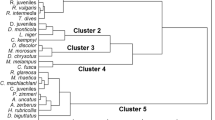Abstract.
The behaviour and surface activity of Pseudorchestoidea brasiliensis (Dana, 1853) was studied at the Boqueirão Beach, southeast Brazil. In May 1995, sampling was performed in two periods of 24 h, the first at neap tide (6–7 May) and the second at spring tide (27–28 May). Sampling was carried out along a transect from the upper limit of swash zone to the base of the dune vegetation. This transect was divided systematically into strata 3 m apart, which varied in number (15 high tide to 19 low tide); three circular pitfalls traps (3.5 cm2) were placed at each stratum along a transect. The animals caught were removed hourly. Surface activity pattern, total and hourly mean zonations were calculated in daily hours at spring and neap tides. Correlation analysis was used to compare the patterns of activity of the age and sex classes in relation to hourly mean zonation, temperature, and tidal height. The results indicate the existence of three peaks of surface activity. The activity peaks were registered at sunrise, at sunset and around midnight. Differences in the activity patterns between juveniles and adults were observed. Adults had nocturnal activity, whereas most juveniles were active at sunset and at sunrise. Hourly mean zonations varied between the two synodic phases, with a probably landward shift at spring tide. During the day, the amphipods occupied 18 m of the intertidal zone, on average, whereas at night this extension was wider (mean 27 m). Activity rhythms of the adults were correlated with sediment temperature. However, the activity rhythms of the juveniles were not correlated with the sediment temperature and they showed a higher activity during the day. The surface activity of the adults and of juveniles were generally not correlated with tidal range. The results provide evidence of the behaviour plasticity of talitrids in which the behaviour and the activity patterns of juveniles and adults enable them to adapt to different sandy beach conditions (morphodynamic states, exposure index, beach slope and swash climate).
Similar content being viewed by others
Author information
Authors and Affiliations
Additional information
Electronic Publication
Rights and permissions
About this article
Cite this article
Cardoso, .R. Behavioural strategies and surface activity of the sandhopper Pseudorchestoidea brasiliensis (Amphipoda: Talitridae) on a Brazilian beach. Marine Biology 141, 167–173 (2002). https://doi.org/10.1007/s00227-002-0784-y
Received:
Accepted:
Issue Date:
DOI: https://doi.org/10.1007/s00227-002-0784-y




